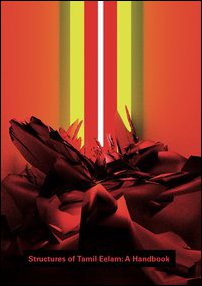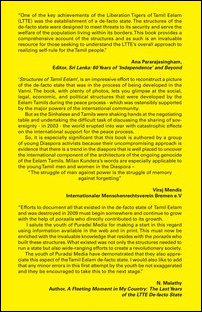Swiss youth group brings out publication on de-facto state of Tamil Eelam
[TamilNet, Wednesday, 01 May 2019, 23:35 GMT]
A Swiss-based Tamil youth group has come up with a print compilation, titled “Structures of Tamil Eelam: A Handbook”, based on online and textual research on the LTTE-run de-facto state of Tamil Eelam. The compilation, made by a 20-year-old author, is structured into eight parts and twenty-six chapters with articles and photographs. “Almost ten years since the destruction of Tamil sovereignty through the global conspiracy conducted at Mullivaikkal, the ongoing nature of Tamil genocide reiterates the need for Eelam Tamils to understand the fundamentals of our struggle in formulating a legitimate path for a permanent political solution for the Tamil struggle,” says the preface of the book. Prominent Tamil and Sinhala diaspora activists and writers of first generation N Malathy (New Zealand), Ana Pararajasingham (Australia) and Viraj Mendis (Germany) have praised the work.
“This handbook has been arranged in a summative manner to allow readers to comprehend the role of the structures of Tamil Eelam and the Tamil leadership in fostering both national and social liberation,” the author states in the preface.
The compilation, which aims at educating the younger generations of Eezham Tamils, will be released in Switzerland on 19 May.
The eight chapters covered in the 225-page book are mainly about the various structures of the LTTE run de-facto state: Political & Administrative, Legal (Law & Order of Tamil Eelam), Media, Economics & Finance, Health, Education, Arts & Culture, and Social Institutions.
Senchudar Gemeni, the young author and the publishers, Puradsi Media, also note that the first version is only a first step and that it is missing many details, which will be added in future releases.
The publication has been carried out in collaboration with ‘Phoenix - the Next Generation’ a youth action group.
“The structures of the de-facto state were designed to meet threats to its security and serve the welfare of the population living within its borders. This book provides a comprehensive account of the structures and as such is an invaluable resource for those seeking to understand the LTTE’s overall approach to realizing self-rule for the Tamil people,” says Ana Pararajasingham, the editor of Sri Lanka: 60 Years of ‘Independence’ and Beyond.
Exiled Sinhala activist Viraj Mendis appreciates that the book has been authored by a group of young Diaspora activists who are known for their uncompromising approach.
"There is a trend in the diaspora that is well placed to uncover the international component of the architecture of the ongoing genocide of the Eelam Tamils. Milan Kundera’s words are especially applicable to the young Tamil men and women in the Diaspora: The struggle of man against power is the struggle of memory against forgetting,” Mr Mendis observes.
N. Malathy, the author of “A Fleeting Moment in My Country: The Last Years of the LTTE De-facto State,” in her blurb to the book: “I salute the youth of Puradsi Media for making a start in this regard using the information available in the web and print. This must now be enriched with the invaluable knowledge that resides with the poraalis [ex-LTTE members] who built these structures. What existed was not only the structures needed to run a state but also wide-ranging efforts to create a revolutionary society.”
“The youth of Puradsi Media have demonstrated that they also appreciate this aspect of the Tamil Eelam de-facto state. I would also like to add that any minor errors in this first attempt by the youth be not exaggerated and they be encouraged to take this to the next stage,” she writes further.
The author of the book notes in the preface that the youth group launched a Social Media (SoMe) initiative named Glimpses of Tamil Eelam (GoTE) in 2017. However, Facebook and Instagram had blocked GoTE accounts and posts.
The SoMe initiative was aiming to create an “online presence to foster political discourse regarding the struggle amongst Eelam Tamils,” through documenting and disseminating visual images from the de-facto state of Tamil Eelam.
GoTE’s posts were made in a structured manner with multiple collections and sub-series: Structures of Tamil Eelam (SoTE), Thalaivar’s Collection, Military Training Collection, Eelam War IV Collection, Sea Tigers Collection, Citizens of Tamil Eelam and Maaveerar of Tamil Eelam (MoTE).
The SoMe censorship on the GoTE project seems to have set the youth group in a better track, namely towards bringing out a compilation in the print form, which the group has named SoTE (Structures of Tamil Eelam).
“It is encouraging to see that the members of the second-generation have embarked on this endeavour to compile the documents and the imagery of Tamil Eelam, especially at the absence of meaningful action in this regard from the first generation outfits in the diaspora,” a former LTTE Political Division member told TamilNet.
This way, the youth would be able to systematise the contents and contextualise the nation and state formation of Eezham Tamils, the ex-LTTE member observed.
Chronology:








